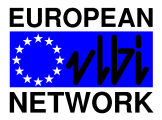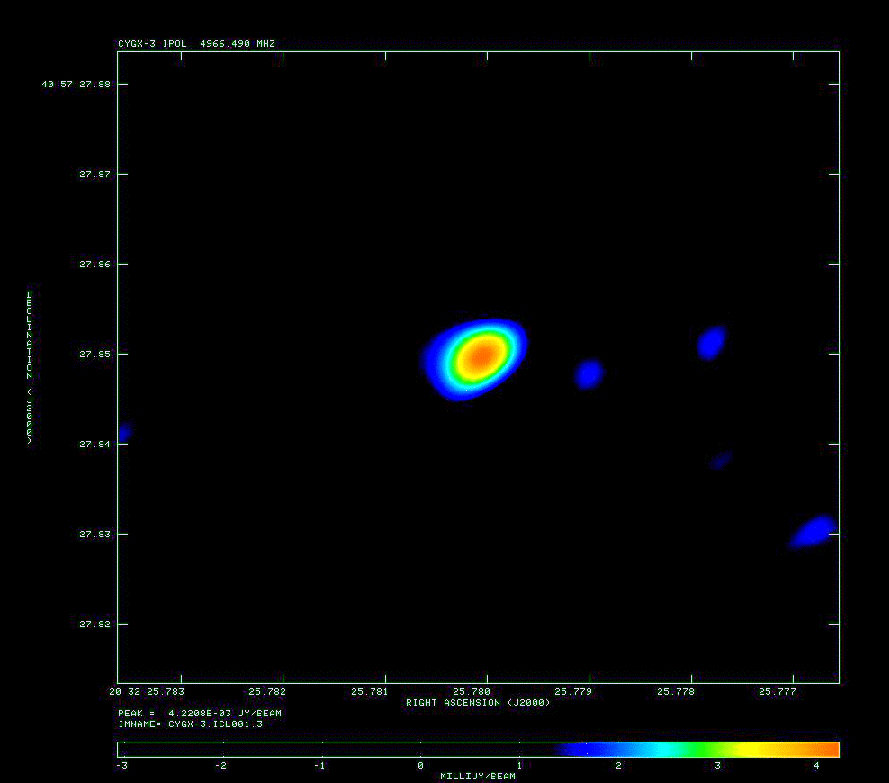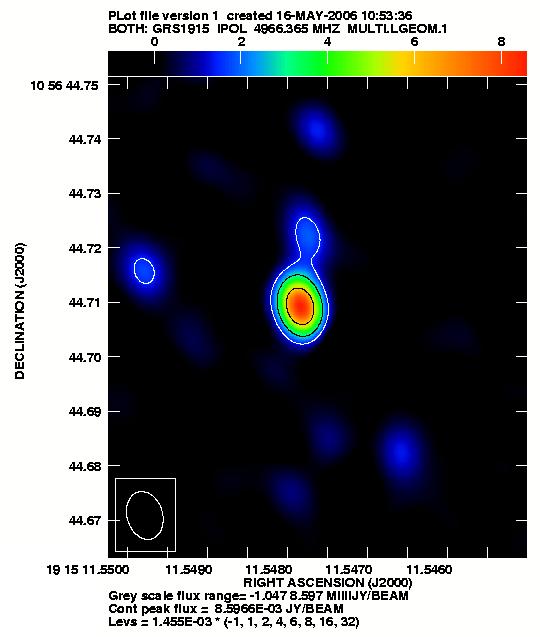
Number 14
May 2006
 |
European VLBI Network
Newsletter Number 14 May 2006 |
| EVN Homepage | Publications | Meetings | User Support | Proposals | JIVE Homepage | Newsletter Archive |
Observing proposals are invited for the EVN, a VLBI network of radio telescopes spread throughout Europe and beyond, operated by an international Consortium of institutes.
The EVN is open to all astronomers. Use of the Network by astronomers not specialised in the VLBI technique is encouraged.
The Joint Institute for VLBI in Europe (JIVE) can provide support and advice on project preparation, scheduling, correlation and analysis.
| 2006 Session 2 | Jun 01 - Jun 20 | 30cm, 18/21cm, 6cm (+MERLIN), 5cm |
| 2006 Session 3 | Oct 19 - Nov 09 | 90cm, 6cm, 5cm, 1.3 cm |
| 2007 Session 1 | February/March | 18/21cm, 6cm, 5cm, +... |
Proposals received by 1 June 2006 will be considered for scheduling in Session 3, 2006 or later. Finalisation of the planned observing wavelengths will depend on proposal pressure. Other wavelengths which may be scheduled in 2006-2007 are 50cm, 3.6cm and 7mm.
Submit to: Richard Porcas, EVN Scheduler, MPIfR, Auf dem Huegel 69, D 53121 BONN, GERMANY or by email to: proposevn@mpifr-bonn.mpg.de. Deadlines: 23:59:59 UTC on 1 Feb, 1 Jun or 1 Oct.
The detailed Call for Proposals has further information on Global VLBI, EVN+MERLIN and guidelines for proposal submission.
The EVN User Guide describes the network and provides general information on its capabilities.
The EVN Status Table gives current antenna capabilities.
The On-line VLBI
catalogue lists sources observed by the EVN and Global VLBI.
The last EVN Consortium Board of Directors, hosted by the INAF-Istituto di Radioastronomia, was held at the Physics Department of the University of Florence, located close to the Arcetri Astrophysical Observatory. The CBD meeting took place on May 18th. The following day the EVN Executive meeting and the JIVE Board were held. These events represented the end of the so called "Tuscany Campaign", started last April in Volterra with the RadioNet meeting, with the participation of many European and extra-European radioastronomers. All the meetings were very successfull.
More than 20 people joined the CBD meeting the first day. Among the participants I like to mention Hans Olofsson, the new Director of the Onsala Space Observatory, who attended the CBD for the first time, and Roy Booth, the former Director, who joined the meeting this time as Hartebeestoek representative. Joe Salah, Director of the Haystack Observatory, told us about scientific and technologal projects in which the observatory was involved. Yasuhiro Murata, from the Institute of Space and Astronautical Science in Japan, made a presentation of the recently approved VSOP-2 project for space VLBI. Invited participants were Juris Zagars, Director of VIRAC (Latvia) and Alexander Konovalenko, Head Department of the Institute of Radio Astronomy (Kharkov, Ukraine) as representative of the stations of Irbene and Evpatoria respectively. Both stations are aspiring to join the EVN in the near future. Alexander Konovalenko could not be with us. However, for both stations we have been informed of the progresses made to have the telescopes fully equipped to take part in a VLBI experiment. Several EVN Institutes are investing resources to achieve the goal of detection of fringes during tests experiments planned for next Summer.
Due to a meeting on VLA Legacy Programmes in Socorro, no one from NRAO could attend the CBD meeting, and a teleconference was organized. Craig Walker, Jim Ulvestad, Jon Romney and Fred Lo, Director of NRAO, could exchange information and comments with the participants of the CBD meeting. A sub-committe was established for the implementation of a global proposal tool to submit proposals.
An extensive discussion on VLBI Recording Systems followed the presentation of status reports on MK5A and B, PC-EVN, Digital Base Band Converters. Results from the first e-VLBI observations were presented. The decision to extend the length of the observing time from 8 to 24 hours was taken, in order to allow tests and science with that technique during a series of scheduled experiments.
Finally, it was briefly discussed the preparation of a "Roadmap to EVN2010", a document aimed to present our vision of the future EVN and its capabilities to produce world-class science.
The next EVN CBD meeting will be held in Dwingeloo, together to the Autumn RadioNet meeting, in late November.
Franco Mantovani
EVN Chairman


With EXPReS now formally underway, the nature of e-VLBI testing has changed. Throughout the year regular time slots have been reserved for e-VLBI, and the first open call for e-EVN science proposals has been issued. This resulted in two science runs, on March 16 and April 20, followed by a Target-of-Opportunity observation on May 18.
The first run on March 16 involved Cm, Jb (MkII), Tr, On, Wb and, for the very first time, Mc. Because of a combination of problems, such as the re-appearance of a software bug, very poor connectivity to Tr and problems with the connection to Mc, most of the run was lost. On a positive note, we saw first real-time fringes to Mc at 128 Mbps, and the actual data transfer went flawlessly, with Geant reporting zero packet loss across their network.
The second run, April 20, was a completely different story, with the same 6 EVN telescopes participating nearly continuously for the full duration of the observations, transferring more than 5 TB of data in real-time to the correlator at JIVE at 128 Mbps.
During the setup/test phase, some new software interfaces intended to facilitate access from JIVE to the Mark5A units at the stations were tested (remotely monitoring, stopping and re-starting the Mark5A control software, even re-booting the units). These were partly successful. During this phase Ar joined in as well, but we were unable to get fringes, even at 32 Mbps.
The science part started at 2100UT. As the two accepted proposals covered more or less the same hour angle range, the observations were scheduled in alternating blocks of about 1 hour.
Very early into the science run, we found that connectivity to Tr was not as good as it had been during the day. What is more, we also had problems reaching the control interface of the Mark5A at Tr, a problem very similar to the one experienced in the past to Mc. Not wanting to loose five telescopes to debugging the problems with one, we ran the schedule anyway. From about 2400UT onwards connectivity to Tr improved enough to join in again, and from that moment on all telescopes transferred data continuously.
Aside from some minor glitches (temporary loss of connectivity, mainly from Tr and, surprisingly, Jb, and some occasional correlator problems forcing re-starts) the whole system worked smoothly and reliably until the next day, 1300UT, the end of the observing schedule.
Although no formal call for proposals had been issued, a Target-of-Opportunity proposal was granted time on the May 18 time slot. The science observations lasted from May 18 2100UT until 945UT the next day and again involved the same 6 European EVN telescopes. The data rate was 128 Mbps, and apart from some short-lived connectivity problem to Mc and some problems with the Mark5 unit at Jb (fixed after a reboot) the run went perfectly smoothly.
During technical tests before the science run the software interfaces with the mark5 units at the stations were tried once again and this time were found to function well. An newly developed integrating fringe display, which makes it possible to see fringes on weak sources, was tested. This is intended to be the default fringe display during the next e-VLBI run.
In the morning before the observations, bwctl measurements from Tr showed an unprecedented 700 Mbps. This, we heard later, was thanks to a change of the network topology in Poland. As a result, we managed the first ever 6-station correlation at 256 Mbps. In addition we saw the first ever European 512 Mbps fringes on the Wb-Jb baseline. Although On mostly performs well at 512 Mbps, in this case a communication failure prevented it from sending data.
As in the previous run, Ar participated for a short time. Unfortunately, although the connection (as checked through iperf tests) seemed adequate to sustain 32 Mbps, this failed again. The search for the bottleneck continues.
Clearly, our efforts to improve reliability and ease of operation are
beginning to pay off, and are turning e-VLBI into a real EVN
operational mode.
All projects in this session were recorded at all stations using MK5A disks, except for a single project correlated at the VLBA correlator for which Effelsberg used tape. This was probably (hopefully !) the last use of tape at an EVN observatory during an EVN session. It was necessary because of the limited number of MK5A playbacks at the VLBA correlator.
All reasonably rated projects requiring the wavebands offered in this session were scheduled, including a full week of 5cm projects, observing both methanol and excited OH lines. Many 5cm projects also included MERLIN. The session was not disk-limited. One project proposed for 256 Mb/s was scheduled at 1 Gb/s to increase the sensitivity (working towards the goal of having this bit-rate as the EVN default, where appropriate). Two of the 3 EVN-only continuum projects were run at 1 Gb/s.
Arecibo was used for 2 user projects, GBT for 2 projects and the DSN-Robledo 70m dish for one. Four of the 13 user projects were global. The VLBA correlator was used for 1 project.
Following the
sixth known outburst since 1898 of the recurrent nova RS
Ophiuchi on 12th February this year, a Target of Opportunity proposal
was submitted to the EVN on 16th February to observe at 18 and 6cm
wavebands. It proved possible to schedule these observations following
the last scheduled project in the session, on March 5th and 6th,
thanks to the generous allocation of time by the EVN observatory
Directors and the efforts of the observatories' and JIVE support
staff.
Richard Porcas - EVN
Scheduler
The European VLBI Network
(EVN) website (http://www.evlbi.org/)
is hosted by the Joint Institute for VLBI in Europe (http://www.jive.nl/).